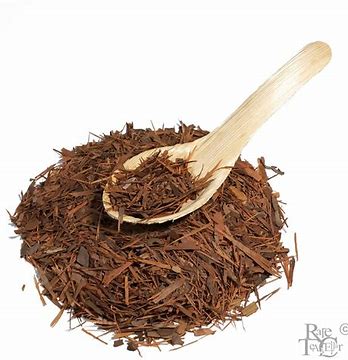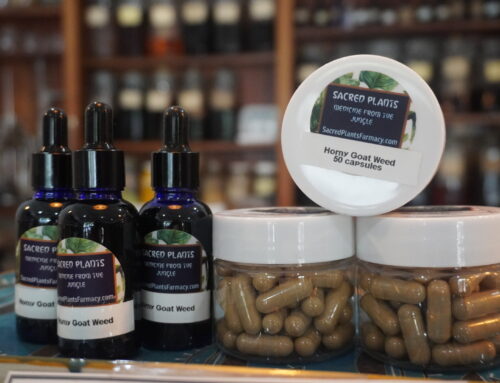Pau d’arco is native to South America, where it has been used to treat a wide range of conditions. There are reports of medicinal uses of pau d’arco tea dating back to 1873, and it was used in the Amazon rainforest as a “miraculous” healer for tumors with impressive anti-inflammatory effects.
Pau d’arco, also called tabebuia avellanedae, is a canopy tree from the Bignoniaceae family with extremely hard wood. Its name is the Portuguese word for “bow stick.” This is an appropriate term because the tree was actually used by native South Americans for making hunting bows.
Pau d’arco is used externally and internally to treat:
- arthritis
- pain
- inflammation of the prostate gland
- fever
- dysentery
- boils
- ulcers
- various cancers
Dose: 10-15 drops under the tongue, 1-3 times daily
Benefits
1. Rich in Lapachol and Other Antioxidants
Pau d’arco tea contains several compounds, including quinoids, benzenoids and flavonoids. These compounds have displayed biological activity against harmful organisms.
Pau d’arco also has a significant amount of lapachol, which comes from the stem of the tree. The U.S. Department of Agriculture indicates that lapachol is known be toxic and resistant to nearly all types of harmful organisms.
A 2005 study published in Oncology Reports found that lapachol has great potential as an application in fighting metastasis, which is the spread of a cancer or other disease from one organ of the body to another. Metastasis is the major process responsible for the death in cancer patients, and the recent research involving lapachol is promising.
Lapachol is also used for its antioxidant and antimicrobial effects, but some research suggests that high doses of this compound can lead to dangerous side effects, like reproductive toxicity. Pau d’arco also contains another chemical called beta-lapachone, which has also demonstrated toxicity to harmful organisms, similar to lapachol.
2. Reduces Pain
Research shows that pau d’arco tea has the power to naturally reduce pain in patients suffering from cancer and other serious health conditions. It has the ability to lessen the pain associated with several kinds of cancer, especially cancer of the prostate, liver or breast.
Consuming pau d’arco tea has also been found to help relieve arthritic pain.
A 2001 study published in BMC Pharmacology examined the antinociceptive (pain-reducing) and antiedematogenic (to reduce swelling) effects of pau d’arco inner bark, measured by experimental models in mice that underwent pain stimulated by nerve cells. The inner bark aqueous extract, administered orally in three different concentrations, reduced the sensory process that provides the signals that lead to pain.
3. Fights Candida
Pau d’arco helps the body fight candida. Candida, also known as candidiasis, is a common yeast infection that has been proven to contribute to many health problems, from a sore throat to serious stomach problems.
The body normally produces yeast in the mouth, vagina, rectum and digestive tracts, and in normal amounts it remains harmless. However, if the body’s natural pH balance is upset, candida symptoms can quickly grow out of control.
4. Reduces Inflammation
An overactive immune system results in the body being flooded with defense cells and hormones that damage tissues. Dietary and environmental toxins build up in the body, and this turns the immune system on — keeping it highly reactive.
This is what leads to inflammation, which is at the root of most diseases.
A 2014 study published in the Journal of Toxicological Sciences found that pau d’arco increased the expression of Nrf2-target genes in the intestine. Nrf2 is a protein that regulates the expression of antioxidant proteins that protect against oxidative damage triggered by injury and inflammation.
The results of this study show that the activation of Nrf2 could mediate the beneficial effects of pau d’arco, particularly in the intestine, which can be severely affected by inflammation.
5. Helps Treat Ulcers
Ulcers are burns that form in the lining of the upper part of the gastrointestinal tract. When they occur in the stomach, they’re called gastric ulcers. If they form in the first part of your small intestine, the duodenum, they’re referred to as duodenal ulcers.
Peptic ulcer disease begins when a weakness in your stomach or intestinal lining allows acid to create an erosion or sore in the lining. It’s the most common type of stomach disease, according to the American Gastroenterology Association.
Ulcers are caused by an increase in stomach acid caused by stress, medications, diet, smoking, alcohol or H. pylori, a type of bad bacteria. The most common ulcer symptom is a burning pain aggravated by stomach acid that comes in contact with the ulcerated area.
A 2013 study published in Phytotherapy Research found that pau d’arco extract significantly accelerated the healing of acetic acid induced gastric ulcers in rats by increasing mucus content and cell proliferation. This suggests that pau d’arco could be a treatment for peptic ulcer diseases in humans.
6. Combats Cancer
One of the most well-known effects of taheebo is its ability to fight cancer and relieve pain associated with cancer. A study conducted by the Dana-Farber Cancer Institute in Boston found that beta-Lapachone, a major compound in pau d’arco tea, is a potential compound to be added to cancer chemotherapy, particularly for prostate cancer.
It has been shown to kill cancer cells in studies conducted on animals. Another 2002 study concluded that beta-lapachone is one of a few novel anticancer drugs currently under active investigation, and it shows promise for chemotherapy alone and especially in combinations.
This powerful compound caused cancer cell death in mice, and the mice did not appear to be adversely affected by the treatment.
7. Provides Antiviral and Antifungal Properties
For thousands of years, pau d’arco has been used as an antiviral herb. The range of viruses stunted by pau d’arco tea extends from those that cause the common cold to those that are responsible for the life-threatening AIDS virus.
It has been shown in both in vitro and in vivo studies to actively inhibit, kill or stunt the growth of several dangerous viruses, including:
- herpes
- polio
- vesicular stomatitis
- avian myeloblastosis
- leukemia
- rous sarcoma virus
The beta-lapochone present in the bark of tabebuia avellanedae actually inhibits the enzymes in virus cells. This directly affects the synthesis of DNA and RNA.
The virus is then no longer able to take control over the reproductive processes of the cell, so it can neither replicate itself nor infect other cells.
Pau d’arco tea has the power to aid in the healing of skin wounds and infections. It’s commonly used to reduce redness and swelling due to skin infections and irritations. This is because of its antifungal and antibacterial properties.
8. Detoxifies the Body
Taheebo extract and tea detoxify the body by removing harmful toxic substances. These toxins include heavy metals, pesticides, preservatives and even residue from chemotherapy.
Pau d’arco has been shown to work as a detoxifier by having a laxative effect. It’s known to loosen bowels, which aids digestion and regularity.
By stimulating the digestive system, pau d’arco tea helps the body rid itself of excess fats and toxins. It’s important to keep foods moving through your body, especially the colon. The colon is the body’s sewage system, but like all healthy and properly functioning sewage systems, it needs to be cleaned, emptied and maintained to function properly.
When we eat highly processed, refined or “fake” foods, our colons become laden with the unhealthy debris from these foods. For this reason, it’s vital to consume detoxifying foods and drinks, like pau d’arco tea, in order to maintain a clean and healthy body.
Pau d’arco tea consumption is one of the best ways to detox. Blood vessels, the lymphatic system, cells, tissue and organs are all detoxified. This allows the body’s systems to function properly and efficiently.
9. Rich in Selenium
Another powerful element of pau d’arco is selenium. It’s an antioxidant that removes free radicals that damage cells and trigger disease.
Selenium is an extremely vital mineral for the human body. Some selenium benefits include its ability to increase immunity, take part in antioxidant activity that defends the body against free radical damage and inflammation, and play a key role in booting metabolism.
A study conducted by the Faculty of Health and Medical Sciences at the University of Surrey found that consuming plenty of naturally occurring selenium has positive antiviral effects, is essential for successful male and female fertility and reproduction, plus reduces the risk of cancer, autoimmune and thyroid diseases. Low selenium status is associated with increased risk of mortality, poor immune function and cognitive decline.
Risks and Side Effects
When consumed in high doses, pau d’arco is possibly unsafe and can cause nausea, vomiting, diarrhea, dizziness and internal bleeding. If you use pau d’arco, make sure to keep track of your doses, and speak to your health care provider if you notice any of these side effects.
Women who are pregnant or breastfeeding should not use pau d’arco because there is not enough information about the safety of these products.
Pau d’arco can delay clotting and might interfere with treatment in people with bleeding disorders. It may increase the chances of bruising as well.
This can also increase the chance of bleeding during and after surgery. Make sure to stop using pau d’arco at least two weeks before a scheduled surgery.
The statements made within this website have not been evaluated by the Food and Drug Administration. These statements and the products of this company are not intended to diagnose, treat, cure or prevent any disease.






